Christmas Island is home to a diverse population of birds, providing a unique mix of tropical and migratory species. From the native Red-footed Booby to the majestic White-breasted Sea Eagle, the birds of Christmas Island are a sight to behold.
With its dense rainforest, lagoons, and coral reefs, Christmas Island is an ideal habitat for a wide variety of avian species. Many of these birds are endemic to the island, with some even being found nowhere else in the world.
This article will explore the fascinating birds of Christmas Island, from their behavior and habitat to the threats they face from human activities.
1. Boobies
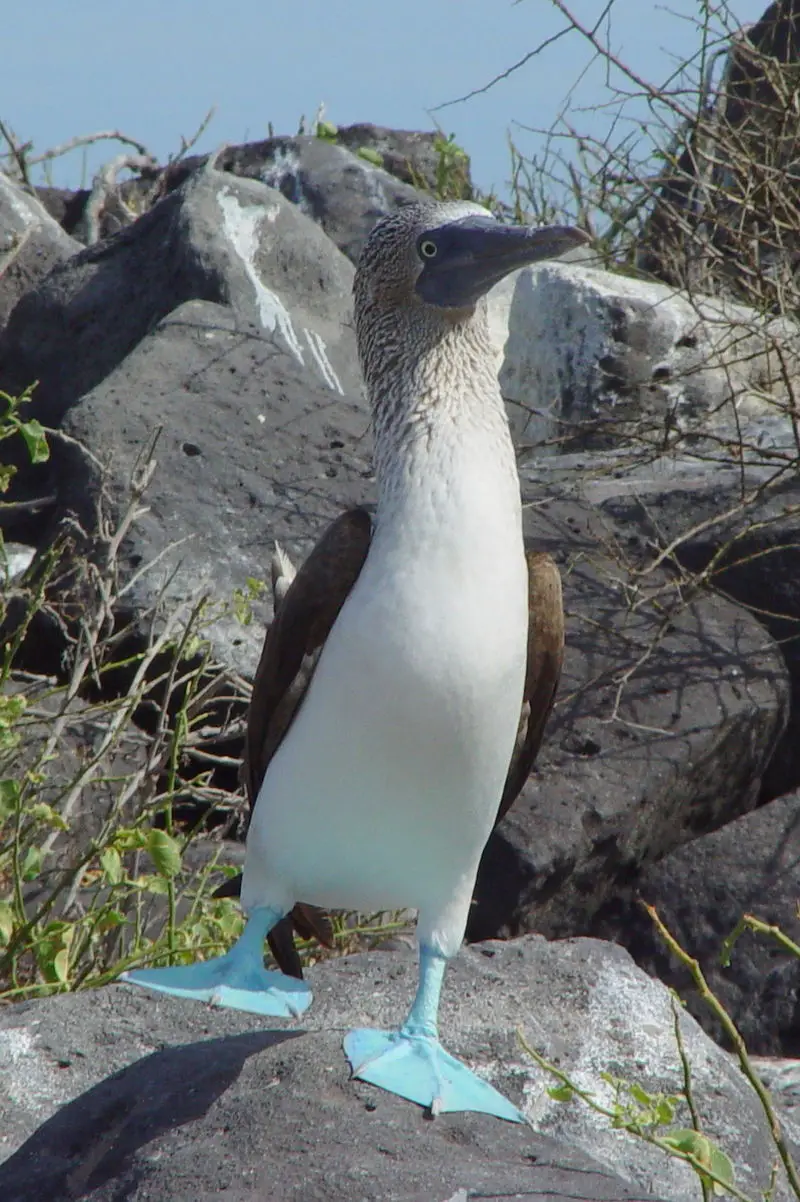
Boobies are seabirds from the family Sulidae. They were originally classified in the genus Sula, and are closely related to gannets (Morus).
Boobies get their name from the Old Norse term “súla,” which was used for another member of their family—the gannet.
These birds can be identified by their brown feathers, long wingspan, webbed feet and sharp bills that they use to catch fish.
Despite being clumsy on land due to their large size and small legs, boobies excel at flying over oceans where they hunt for food with great agility and grace.
Their powerful flaps help them dive quickly underwater as well.Scientific classification:
| Kingdom | Animalia |
| Phylum | Chordata |
| Class | Aves |
| Order | Suliformes |
| Family | Sulidae |
| Genus | Sula Brisson, 1760 |
2. Christmas Frigatebird
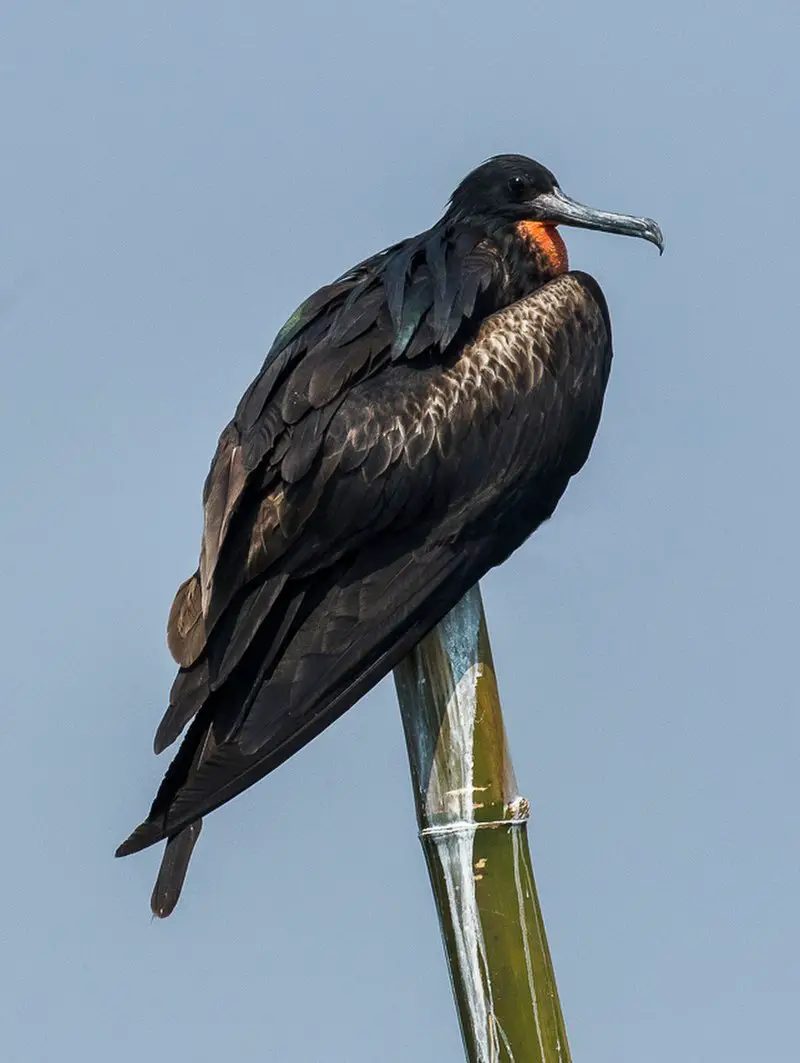
The Christmas frigatebird is a large seabird endemic to Christmas Island in the Indian Ocean.
It has an impressive wingspan of seven feet and brownish-black plumage, with long narrow wings and deeply forked tail.
The male possesses an egg shaped red gular pouch which it inflates during courtship displays.
This species can be seen soaring high into the air on thermals or gliding over open water while searching for food such as flying fish, squid, jellyfish and crustaceans.
During breeding season they form huge mixed colonies where their loud cackles often fill the sky.
Through conservation efforts this threatened species is making a comeback despite its vulnerability to habitat loss due to human activities like land development or fishing nets that may entangle them at sea.Scientific classification:
| Kingdom | Animalia |
| Phylum | Chordata |
| Class | Aves |
| Order | Suliformes |
| Family | Fregatidae |
| Genus | Fregata |
| Species | F. andrewsi |
Also Featured In: Birds of Karnataka, Common Birds of Ko Lanta
3. Red-Footed Booby
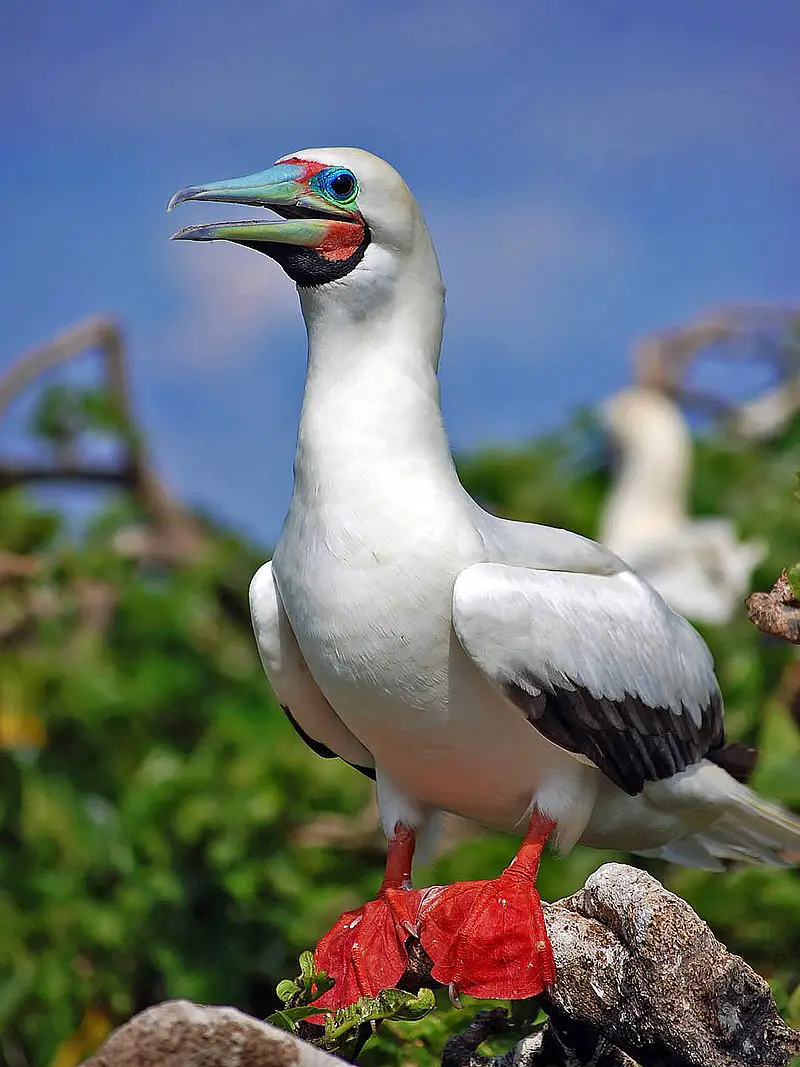
The Red-footed Booby is a large seabird of the Sulidae family, easily distinguished by its bright red feet. These birds are strong and agile fliers but can be clumsy in takeoffs and landings.
They live mostly in tropical areas and breed colonially on coastal islands all over the world.
The species faces few threats from either nature or humans, however their population has decreased slightly due to disturbances near breeding sites.
Despite this mild decline, they remain an incredibly common sight across many parts of the tropics – so much so that they have become symbolic with island life.Scientific classification:
| Kingdom | Animalia |
| Phylum | Chordata |
| Class | Aves |
| Order | Suliformes |
| Family | Sulidae |
| Genus | Sula |
| Species | S. sula |
4. Brown Booby
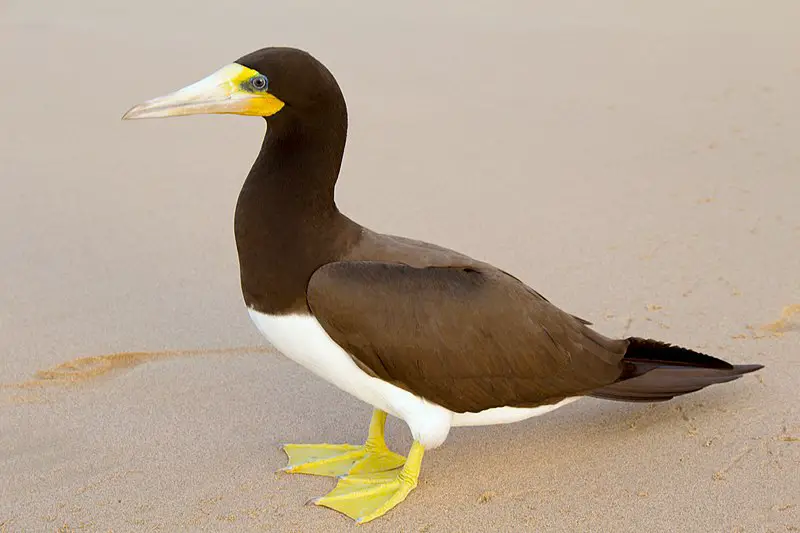
The Brown Booby is a large, seabird from the booby family Sulidae. It has a pantropical range and can be found in many areas of the world.
This bird lives in flocks and forages by plunging into shallow waters to catch small fish that are driven near the surface by predators or storms.
The brown booby is known for its short wings which make it highly maneuverable when hunting; this allows it to pursue prey quickly with sudden turns and dives.
Its diet also includes squid, crustaceans, eggs of other birds, as well as scraps from boats or ships they may come across while flying around coastlines.
They sometimes rest on floating objects during their long flights over open water between islands or continents.Scientific classification:
| Kingdom | Animalia |
| Phylum | Chordata |
| Class | Aves |
| Order | Suliformes |
| Family | Sulidae |
| Genus | Sula |
| Species | S. leucogaster |
5. White-Tailed Tropicbird
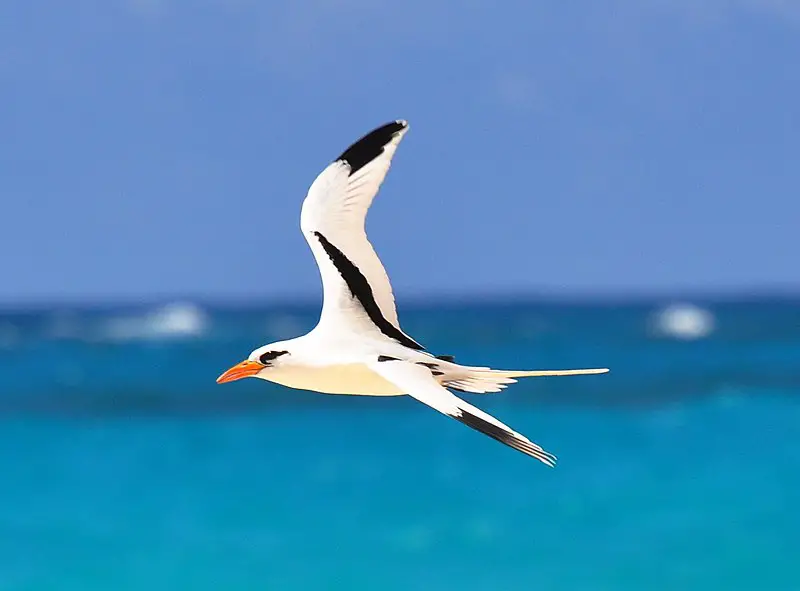
The White-tailed Tropicbird is a beautiful seabird that lives in the tropical waters of the Atlantic, Pacific, and Indian Oceans.
It is the smallest member of its order Phaethontiformes, measuring only 28 inches from head to tail.
Its wingspan can reach up to 45 inches wide. The bird has white plumage with black markings on its wings and tail feathers.
It also has an unmistakable long streamer which trails out behind them when they are in flight – a characteristic feature for all tropicbirds.
They nest mainly on remote islands throughout their range but have recently begun nesting on Little Tobago as well.
These birds feed primarily off flying fish or squid near the ocean’s surface during daylight hours before returning back home at nightfall.Scientific classification:
| Kingdom | Animalia |
| Phylum | Chordata |
| Class | Aves |
| Order | Phaethontiformes |
| Family | Phaethontidae |
| Genus | Phaethon |
| Species | P. lepturus |
6. Christmas White-Eye
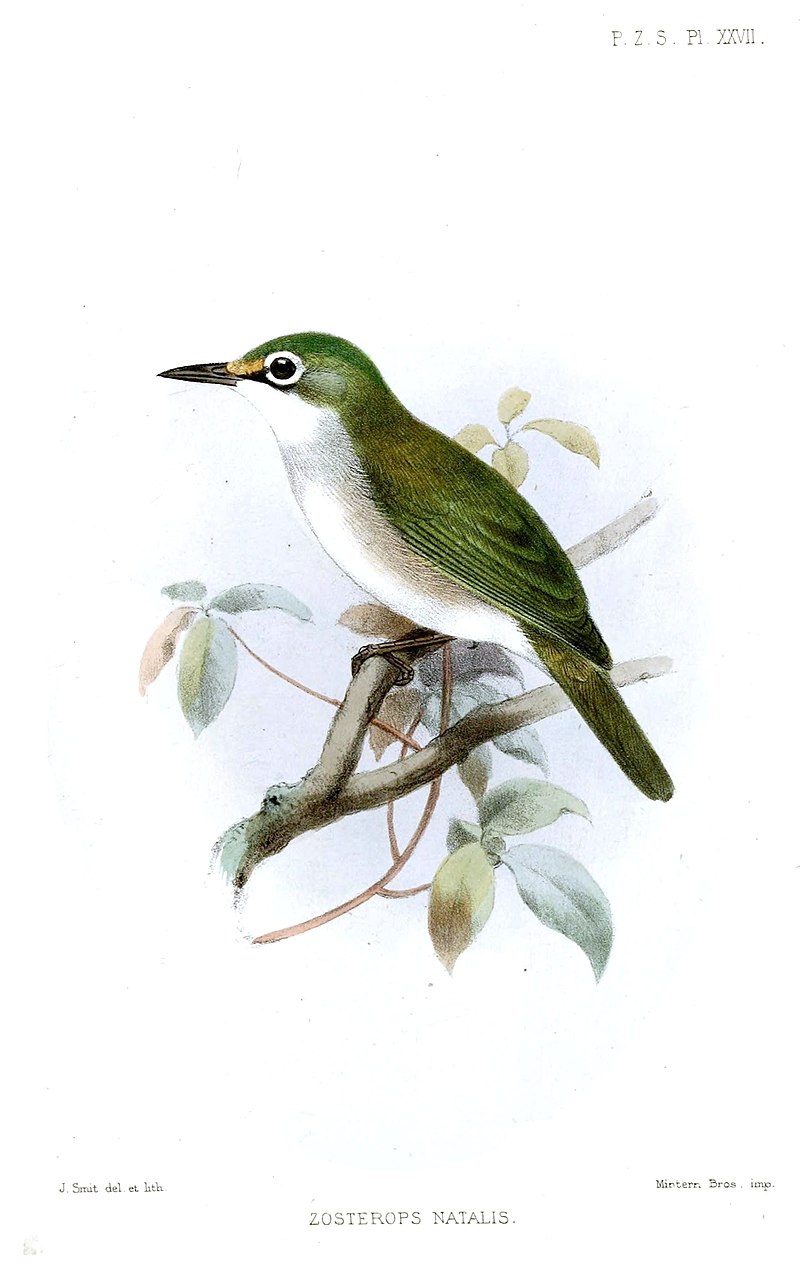
The Christmas White-eye is a small bird that can be found in the tropical and subtropical moist forests of Christmas Island. It has a length of 11.7 to 13.5 cm, with greyish upper parts and yellow underparts streaked with black on its throat, chest, flanks and belly area.
Its wings are brownish grey while its tail is tipped pale blue-grey or white.
This species feeds mainly on insects but may feed also on fruits for food consumption during breeding season when it nests near tree trunks or large bushes inside dense vegetation areas where they lay two eggs per clutch.
Unfortunately this beautiful creature is threatened by habitat destruction as their natural habitats get destroyed due to human activities such as logging, mining and farming practices making it difficult for them to find suitable places for nesting sites which affects their population growth rate negatively putting them at risk of extinction if not taken immediate actions towards conservation efforts quickly enough before more damage occurs.Scientific classification:
| Kingdom | Animalia |
| Phylum | Chordata |
| Class | Aves |
| Order | Passeriformes |
| Family | Zosteropidae |
| Genus | Zosterops |
| Species | Z. natalis |
Also Featured In: Island White Birds That Live In,
7. Nankeen Kestrel
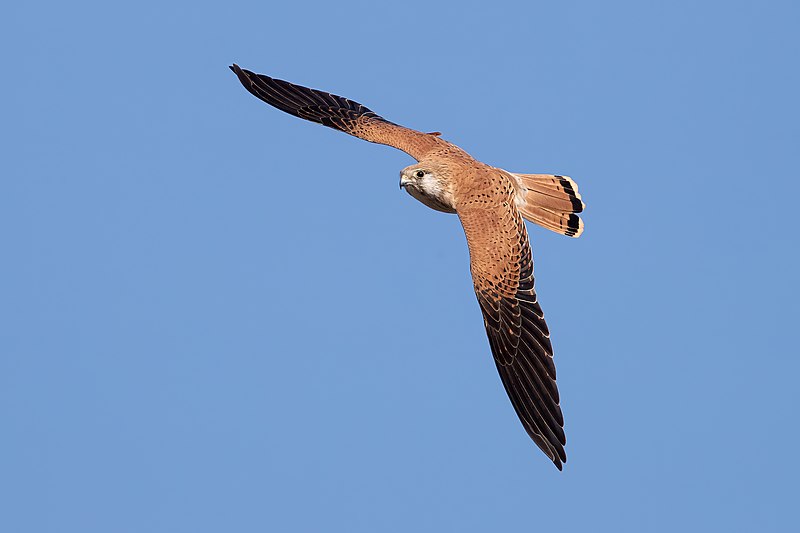
The nankeen kestrel is a small bird of prey native to Australia and New Guinea. Unlike many raptors, it does not rely on speed to capture its prey; instead, it perches in an exposed spot or hovers over fields and grasslands.
It belongs to the genus Falco which also includes other species such as peregrine falcons.
This bird typically has cinnamon-brown upperparts with dark wings and tail whilst its underside is usually pale buffish-white colouring with narrow black barring across the chest area.
Its diet consists mainly of insects but can include reptiles, amphibians, mice and even some birds among others depending on their availability within their habitat range.
The Nankeen Kestrel is an important part of our ecosystems providing essential services such as pest control for farmers by preying upon pests like locusts while also being a keystone species that influences surrounding habitats through predation or competition for resources amongst other animals.Scientific classification:
| Kingdom | Animalia |
| Phylum | Chordata |
| Class | Aves |
| Order | Falconiformes |
| Family | Falconidae |
| Genus | Falco |
| Species | F. cenchroides |
Also Featured In: Birds that Live around Brisbane, Queensland Birds You Should Know
8. Christmas Imperial Pigeon
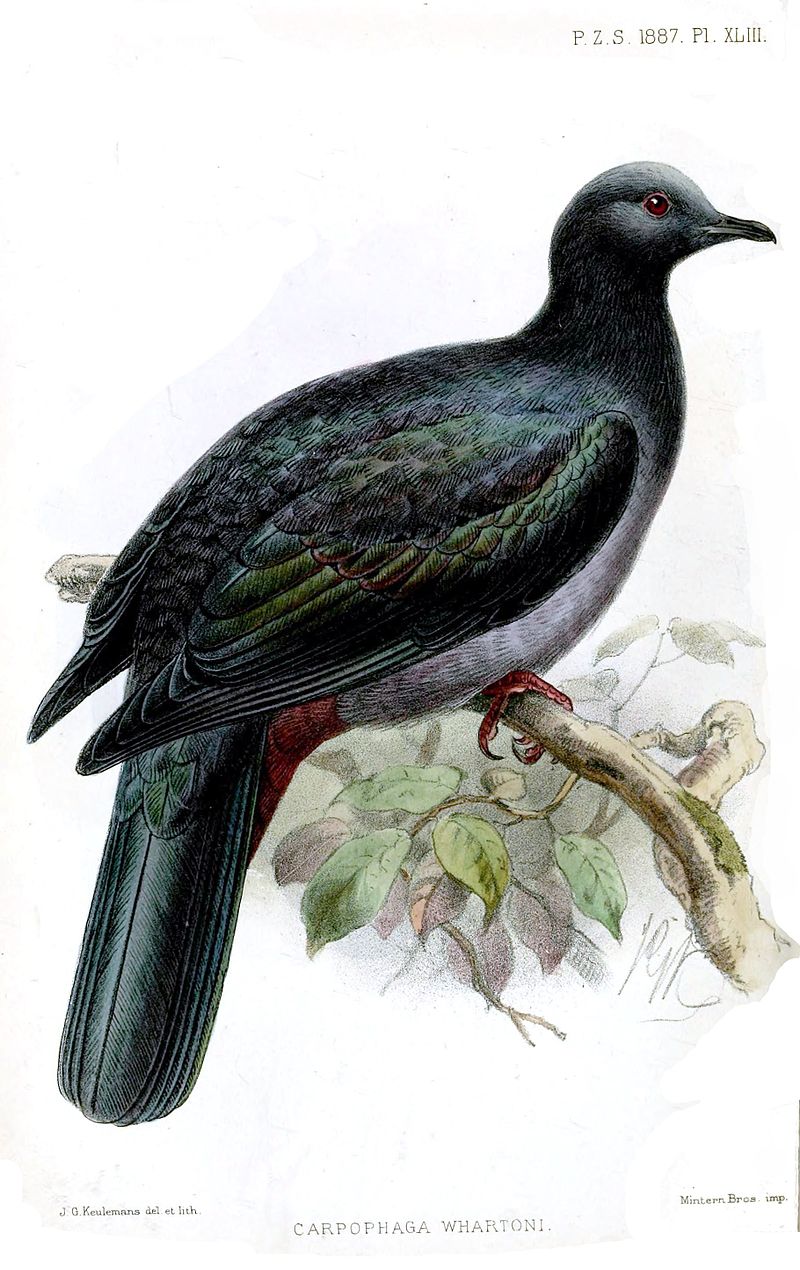
The Christmas imperial pigeon is a large, grey-blue bird endemic to the Christmas Island in Indian Ocean. It has duller feathers than adults and makes soft cooing noises as well as deeper whoo sounds similar to an owl’s call.
These birds feed on fruits such trees like Terminalia catappa and Pometia pinnata, which are abundant on this island. They also sometimes eat small insects or larvae when food sources become scarce during dry season.
This species of pigeon is considered vulnerable due to its limited range and deforestation of their habitat by humans for timber harvesting and other activities that can disturb these birds nesting sites.
Conservation efforts should be made so we can help protect them from further decline in population numbers.Scientific classification:
| Kingdom | Animalia |
| Phylum | Chordata |
| Class | Aves |
| Order | Columbiformes |
| Family | Columbidae |
| Genus | Ducula |
| Species | D. whartoni |
9. Red-Tailed Tropicbird
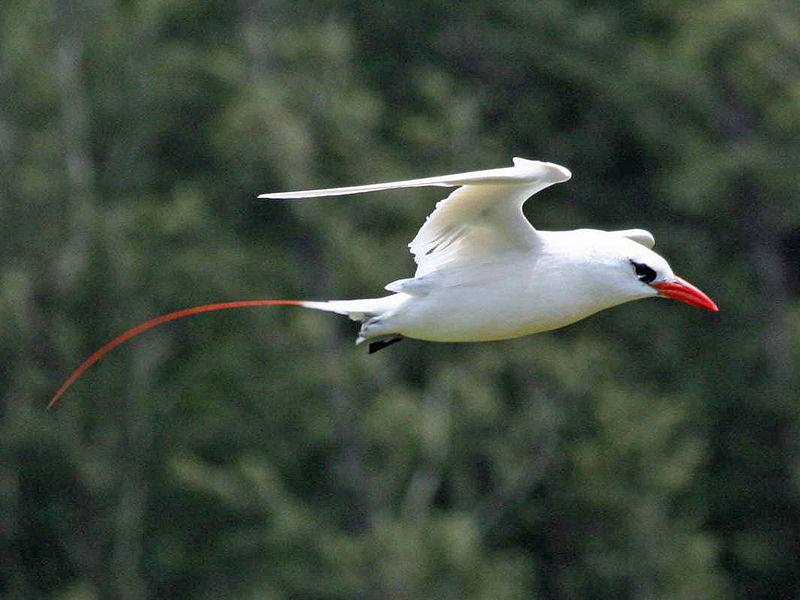
The Red-tailed Tropicbird is an exotic seabird found in tropical areas of the Indian and Pacific Oceans. It has a striking appearance, with mostly white feathers and a black mask covering its eyes.
Its bill is bright red, making it stand out against its pale plumage. Both males and females have similar looks to one another – unlike many other birds species where the male looks significantly different from that of the female.
Described by Pieter Boddaert in 1783, this impressive bird can be seen soaring through tropical skies looking for food either alone or within small flocks made up of several individuals at once.Scientific classification:
| Kingdom | Animalia |
| Phylum | Chordata |
| Class | Aves |
| Order | Phaethontiformes |
| Family | Phaethontidae |
| Genus | Phaethon |
| Species | P. rubricauda |
10. Christmas Boobook
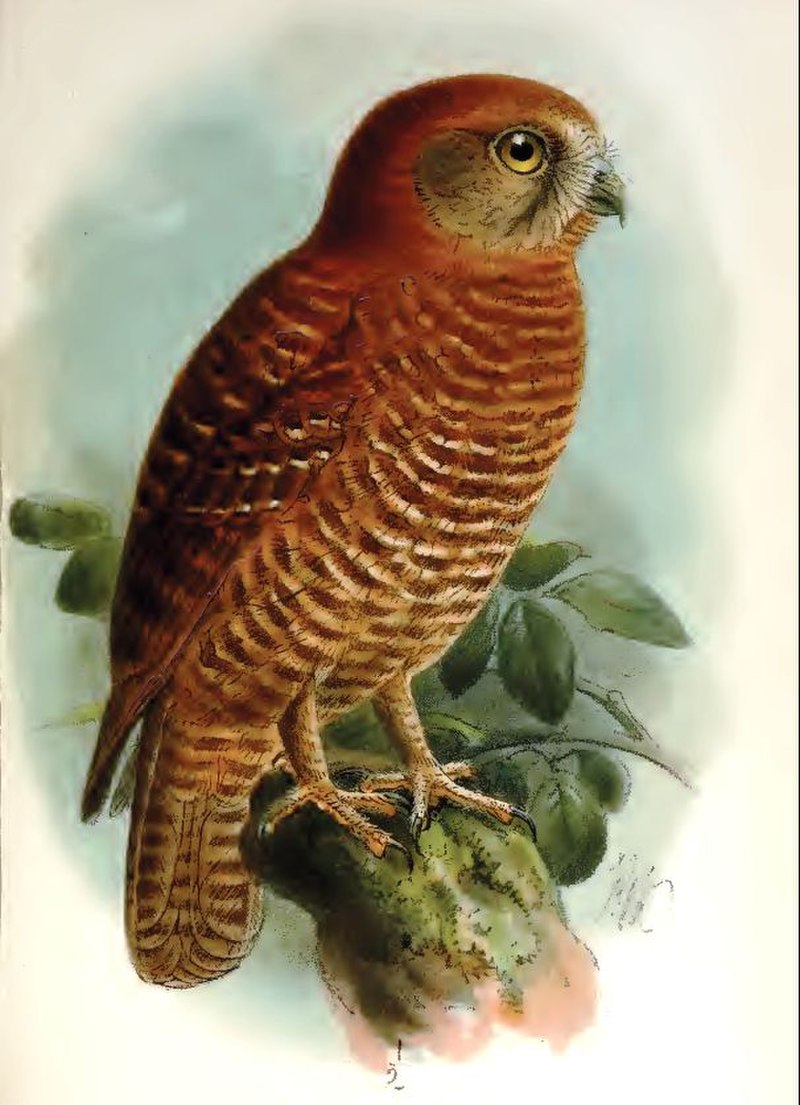
Christmas boobook is a species of owl belonging to the family Strigidae. It was first classified as a distinct species by J.J Lister in 1888, but it wasn’t until 1998 that DNA tests confirmed its separate status from other hawk-owls found in Southeast Asia and Australia.
This nocturnal bird has large yellow eyes with black pupils and brown upperparts, while their white underparts are streaked with dark bars.
They feed on insects such as crickets, moths and beetles which they hunt at night using their excellent vision aided by an acute sense of hearing.
Christmas Boobooks also have a distinctive call consisting of three hoots followed by four softer notes that can be heard echoing through forests during mating season between May – July each year.Scientific classification:
| Kingdom | Animalia |
| Phylum | Chordata |
| Class | Aves |
| Order | Strigiformes |
| Family | Strigidae |
| Genus | Ninox |
| Species | N. natalis |
11. Island Thrush
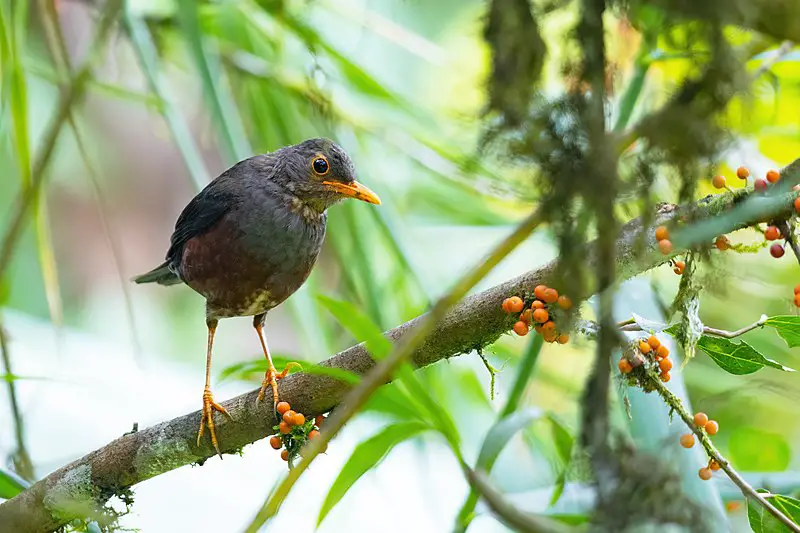
The Island Thrush is a common songbird found in forests throughout Southeast Asia, Melanesia, and Samoa. With nearly 50 subspecies, this species shows great variation in plumage colouration.
Unfortunately, some of these are now threatened or even extinct due to habitat destruction and other human activities.
This bird belongs to the genus Turdus (Linnaeus 1758), which includes many cosmopolitan avian species around the world.
The Island Thrush has strong legs with long toes that allow it to climb easily on branches while searching for food such as insects and fruits. Its loud melodious songs add charm to its natural environment.Scientific classification:
| Kingdom | Animalia |
| Phylum | Chordata |
| Class | Aves |
| Order | Passeriformes |
| Family | Turdidae |
| Genus | Turdus |
| Species | T. poliocephalus |
12. Common Emerald Dove
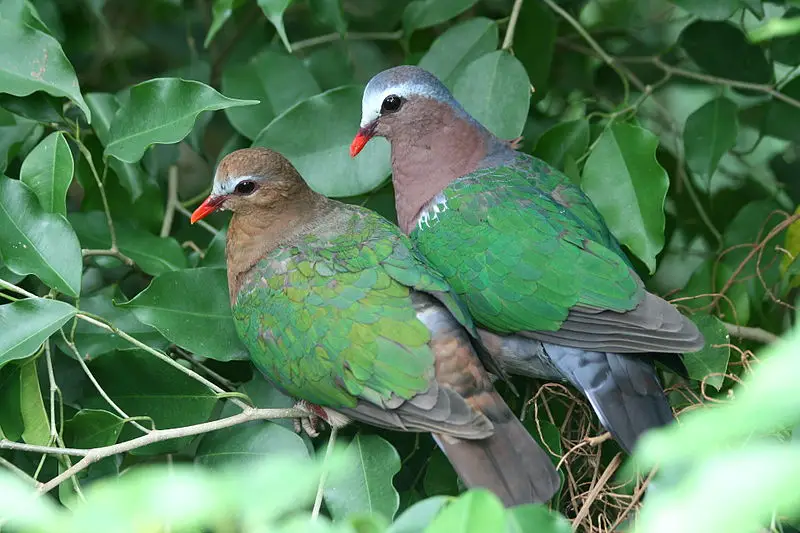
The Common Emerald Dove is a beautiful bird that can be found in tropical and subtropical parts of the Indian Subcontinent and Southeast Asia.
Its distinctive features include its grey-capped head, while its wings are an emerald green colour.
It has also earned itself the nickname “green dove” or “green-winged pigeon”. This species plays an important role in Tamil Nadu’s ecology, which makes it fitting for them to have named it their state bird.
The Pacifric Emerald Dove is closely related to this species but they differ slightly in appearance and habitat preferences; however both make great pets due to being gentle by nature.Scientific classification:
| Kingdom | Animalia |
| Phylum | Chordata |
| Class | Aves |
| Order | Columbiformes |
| Family | Columbidae |
| Genus | Chalcophaps |
| Species | C. indica |
13. Brown Noddy
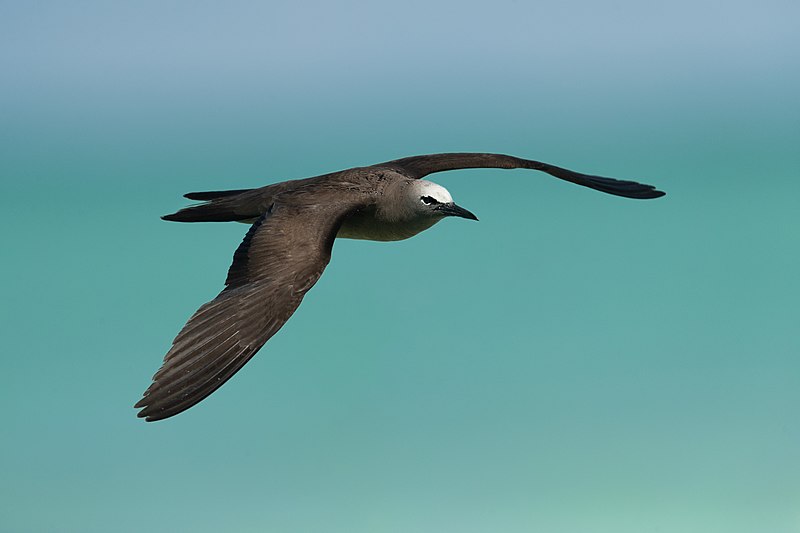
The Brown Noddy is a species of seabird in the Laridae family. It’s the largest of its kind, and can be distinguished from others by its dark brown plumage, which stands out compared to other noddies with black feathers.
Found around tropical oceans worldwide, it inhabits areas such as Hawaii and Australia all the way to Tuamotu Archipelago in Polynesia.
During breeding season they form large colonies on remote islands where their nests are constructed using twigs and leaves situated atop trees or shrubs – typically located near water sources like lagoons or estuaries so they have access to food items like small fish and squid that make up their diet.
As highly social birds they often engage in synchronised flying displays over nesting sites before returning back home at nightfall.Scientific classification:
| Kingdom | Animalia |
| Phylum | Chordata |
| Class | Aves |
| Order | Charadriiformes |
| Family | Laridae |
| Genus | Anous |
| Species | A. stolidus |
14. Great Frigatebird
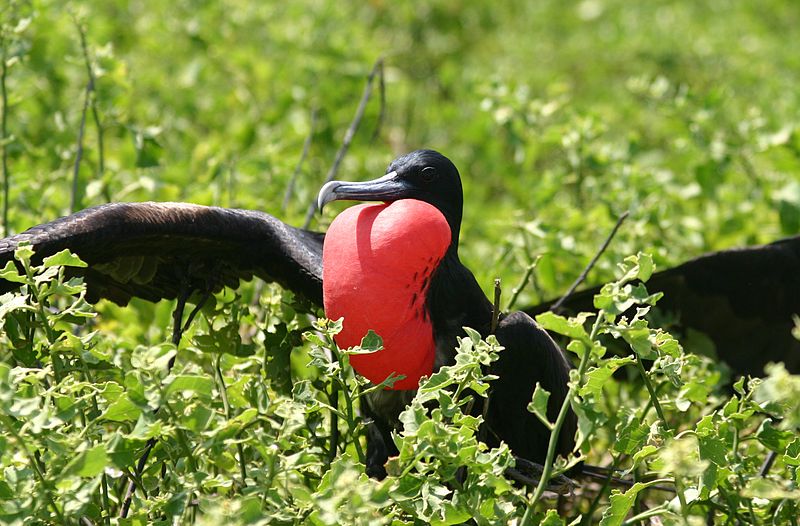
The Great Frigatebird is a large seabird found in tropical regions of the Pacific and Indian Oceans, as well as the South Atlantic.
It can grow up to 105 cm long with black plumage, making it one of the largest frigatebirds around.
The species also exhibits sexual dimorphism; males have bright red throat pouches while females have white or grey ones instead.
These birds nest in colonies on islands or near coastal areas where they feed off fish schools, squid and other marine life that they snatch from their dive-bombing prey.
They are highly adept at soaring for hours above oceanic waters searching for food sources below them before dives down into shallow water to catch unsuspecting meals.Scientific classification:
| Kingdom | Animalia |
| Phylum | Chordata |
| Class | Aves |
| Order | Suliformes |
| Family | Fregatidae |
| Genus | Fregata |
| Species | F. minor |
Also Featured In: Birds of Kauai, Hawaii, Galapagos Birds You Should Know
15. Lesser Frigatebird
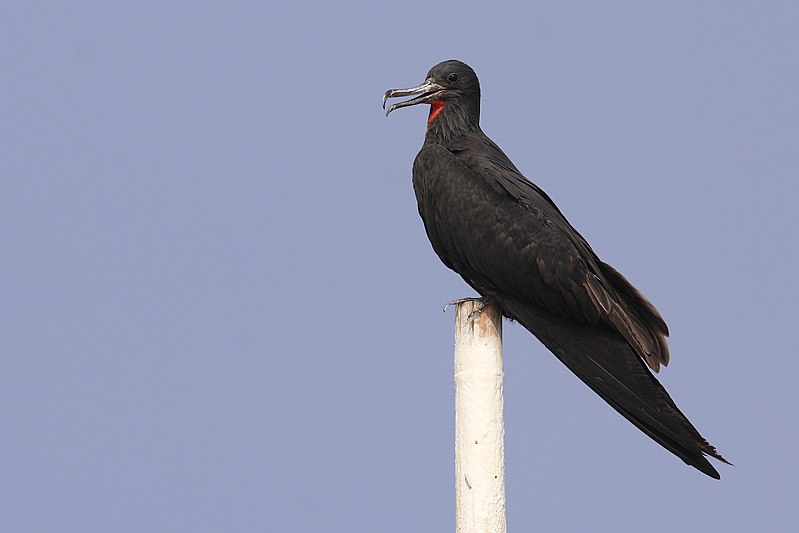
The Lesser Frigatebird is a seabird of the Fregatidae family and is known to be the smallest species in this group. It has brownish-black plumage, long narrow wings, and a forked tail.
This bird inhabits tropical and subtropical regions across the Indian Ocean, Pacific Ocean as well as off Brazil’s Atlantic Coast.
It feeds on fish taken from surface water or by plunge diving while flying low over shallow waters.
Its primary breeding grounds are located around islands with steep cliffs where it builds its nests out of twigs and grasses high up near ledges or crevices.
The lesser frigatebird can live for about 25 years due to their strong aerodynamic abilities which allow them to glide through air currents effortlessly thus conserving energy during flights that last days at a time.Scientific classification:
| Kingdom | Animalia |
| Phylum | Chordata |
| Class | Aves |
| Order | Suliformes |
| Family | Fregatidae |
| Genus | Fregata |
| Species | F. ariel |
16. Christmas Goshawk
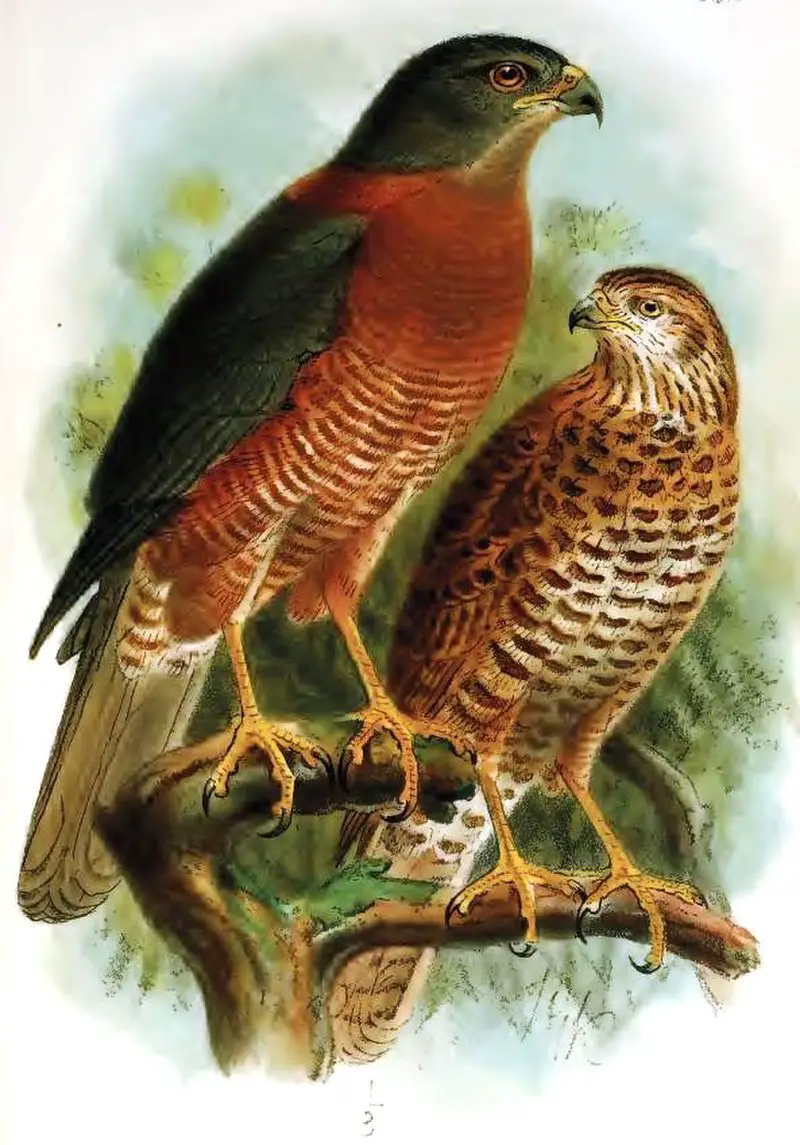
The Christmas goshawk (Accipiter fasciatus natalis) is an endemic bird of prey found only on the Australian territory of Christmas Island in the eastern Indian Ocean.
This threatened species was first described by Lister in 1889, and since then its relationship to other Accipitridae has been a subject of debate.
Despite this uncertainty, it is known that they are powerful hunters with sharp eyesight and swift flight capabilities which enable them to catch their small mammal and reptile prey.
They have brownish-grey plumage above with barred underparts as well as yellow legs and cere.
The conservation status for these birds remains precarious; however captive breeding programs may help ensure their survival into future generationsScientific classification:
| Kingdom | Animalia |
| Phylum | Chordata |
| Class | Aves |
| Order | Accipitriformes |
| Family | Accipitridae |
| Genus | Accipiter |
| Species | A. fasciatus |
| Subspecies | A. f. natalis |
17. Pacific Reef Heron
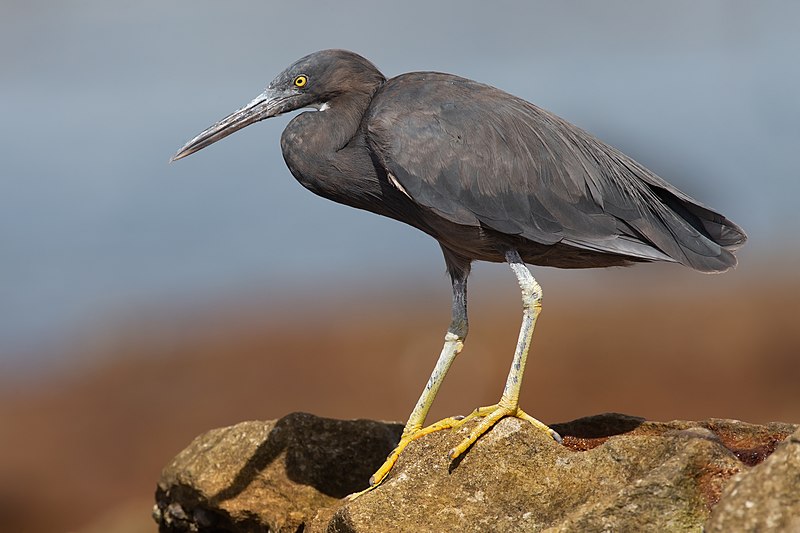
The Pacific reef heron is a species of heron found throughout Southern Asia and Oceania. It has two distinct colour morphs, one with slaty grey plumage and the other fully white.
This bird is easily identifiable by its long legs and yellow bill which are used to forage in shallow water bodies.
The sexes look alike except for minor differences such as size or body shape.
They feed on small fish, amphibians, crustaceans and molluscs that they find near reefs or mangroves where they roost during day time hours often preening their feathers if disturbed by predators like hawks or eagles .
When breeding season arrives these birds become more vocal using loud honking calls to attract mates before settling down into nests built among trees around wetlands or coastal areas.Scientific classification:
| Kingdom | Animalia |
| Phylum | Chordata |
| Class | Aves |
| Order | Pelecaniformes |
| Family | Ardeidae |
| Genus | Egretta |
| Species | E. sacra |
18. Christmas Thrush
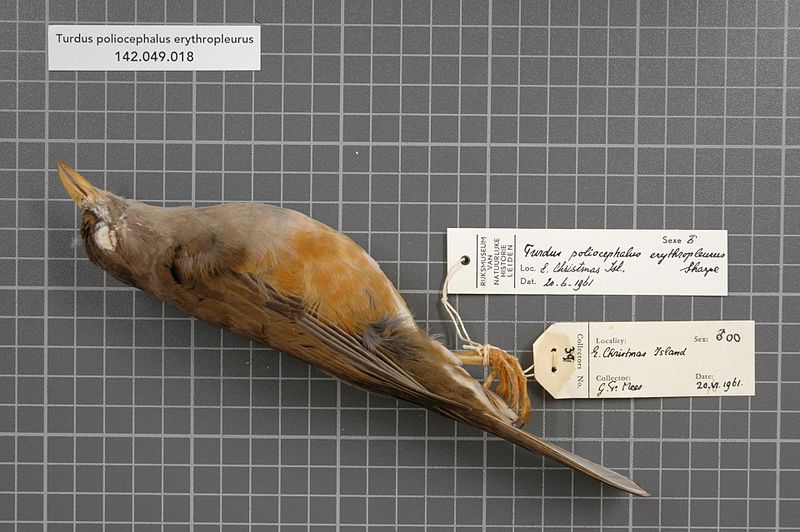
The Christmas Thrush is a beautiful bird endemic to the Australian territory of Christmas Island in the Indian Ocean. It has a grey-brown head and upper breast, with olive brown upperparts.
The flanks, lower breast and sides of belly are an eye catching orange color contrasted against its white belly.
This species forages on the ground in small groups or alone but will come together during breeding season to form large colonies where they build their nests from twigs and mosses high up in trees close by water sources such as streams or rivers.
Its diet consists mainly of insects supplemented with fruit making it omnivorous like many other thrushes found across Europe, Asia and North America respectively.Scientific classification:
| Kingdom | Animalia |
| Phylum | Chordata |
| Class | Aves |
| Order | Passeriformes |
| Family | Turdidae |
| Genus | Turdus |
| Species | T. poliocephalus |
| Subspecies | T. p. erythropleurus |
19. Brown Goshawk
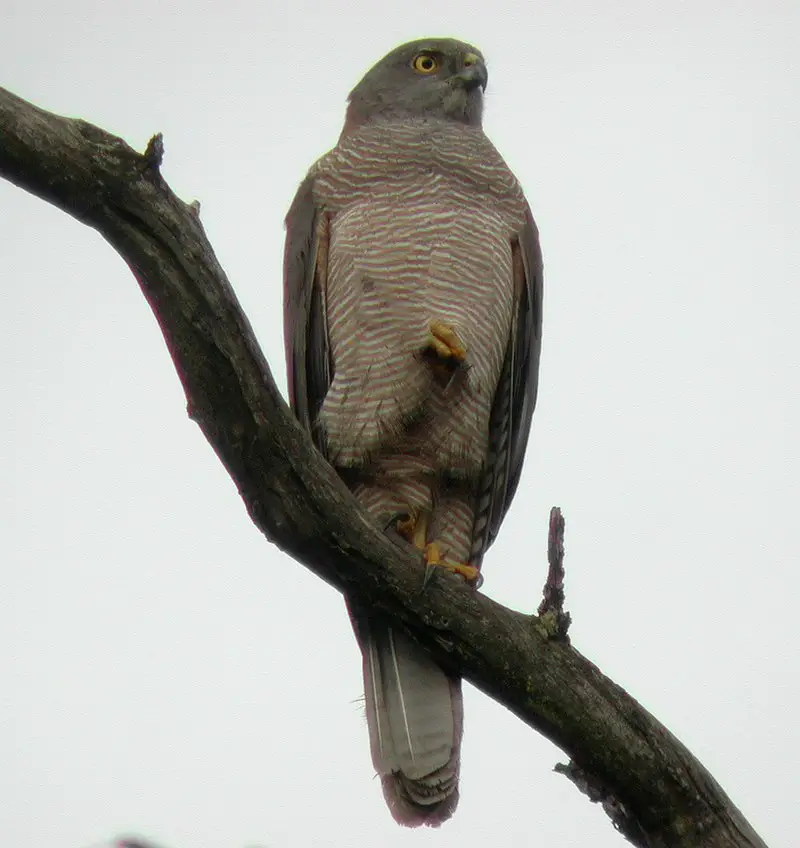
The Brown Goshawk is a medium-sized bird of prey that can be found in Australia and its surrounding islands.
It has grey upperparts with chestnut collar, while the underparts are mainly rufous finely barred with white.
This gives it similar colouring to collared sparrowhawk but it is larger as compared to them; body length being between 40-55 cm.
The flight of this majestic raptor is fast and flexible making for an impressive sight when spotted in the sky.
Its diet consists mostly of small birds, mammals such as rodents or bats, large insects like grasshoppers etc., thus playing an important role in maintaining balance within local ecosystems by controlling population numbers these species.Scientific classification:
| Kingdom | Animalia |
| Phylum | Chordata |
| Class | Aves |
| Order | Accipitriformes |
| Family | Accipitridae |
| Genus | Accipiter |
| Species | A. fasciatus |
20. Pied Stilt
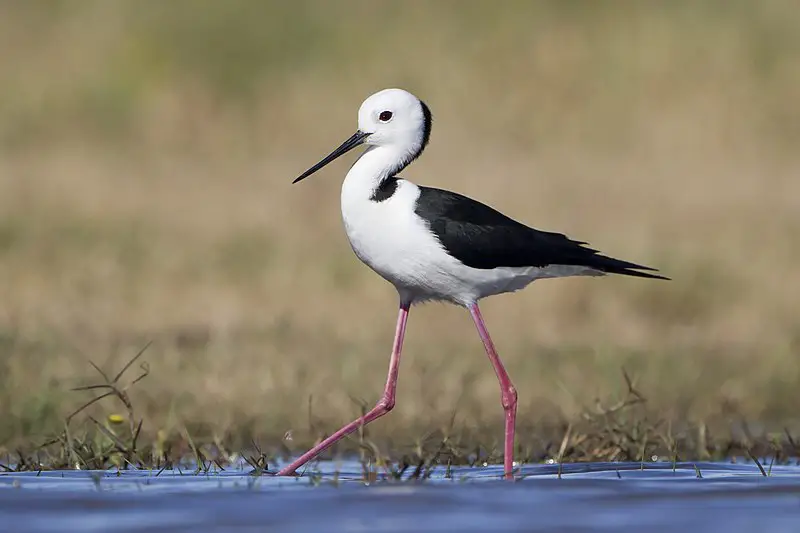
The Pied Stilt is a shorebird belonging to the family Recurvirostridae, and can be found in Malaysia, Japan, Philippines, Brunei, Christmas Island and other parts of Asia as well as Australia and New Zealand.
It has an impressive total population size with no apparent decline in numbers. This species stands out thanks to its white head which contrasts against its black neck and back feathers.
When feeding they wade through shallow waters or mudflats searching for small aquatic animals such as insects or crustaceans that make up their diet.
These birds are highly gregarious when nesting but disperse during winter months due to food shortage on the breeding grounds making them difficult to observe during this time of year.
Though currently listed as Least Concern by IUCN there could still be potential threats from human activities like habitat destruction so it’s important we continue monitoring populations closely into future years.Scientific classification:
| Kingdom | Animalia |
| Phylum | Chordata |
| Class | Aves |
| Order | Charadriiformes |
| Family | Recurvirostridae |
| Genus | Himantopus |
| Species | H. leucocephalus |
Also Featured In: Birds that You’ll find in Perth, Common Birds of Indonesia
21. Australian Pratincole
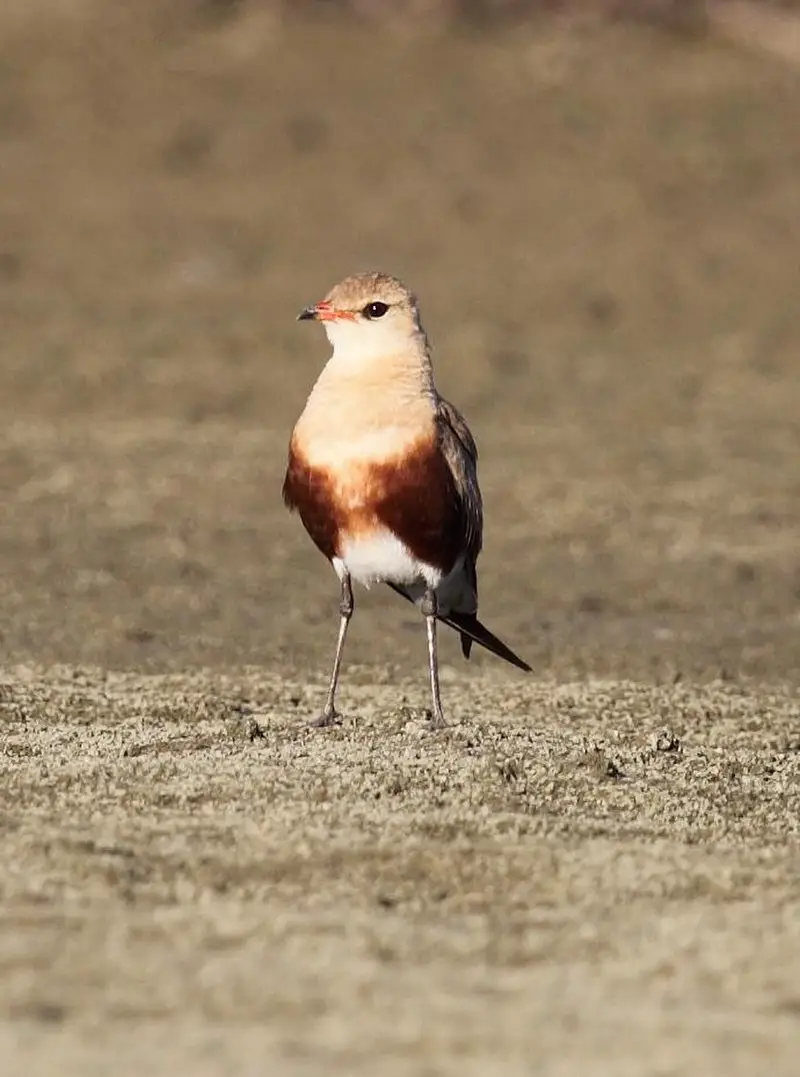
The Australian Pratincole is a species of bird belonging to the Glareolidae family. It inhabits Australia’s interior, with winter migrations extending into northern and eastern parts of the continent, Indonesia and New Guinea.
This medium-sized shorebird can be found in arid regions across central Australia where it breeds. Its range extends from south-western Queensland through to northern Victoria.
They have an elegant appearance due to their long wings and legs which make them well adapted for living on open plains and grasslands as they hunt insects using its unique aerial swooping technique.
The diet also consists primarily of beetles, flies, crickets etc., along with some seeds when available during dry periods or droughts in certain areas within their habitat range.
These birds are known for their social behaviour; often seen forming large flocks that can number up to thousands.Scientific classification:
| Kingdom | Animalia |
| Phylum | Chordata |
| Class | Aves |
| Order | Charadriiformes |
| Family | Glareolidae |
| Genus | Stiltia G.R. Gray, 1855 |
| Species | S. isabella |
22. Tiger Shrike
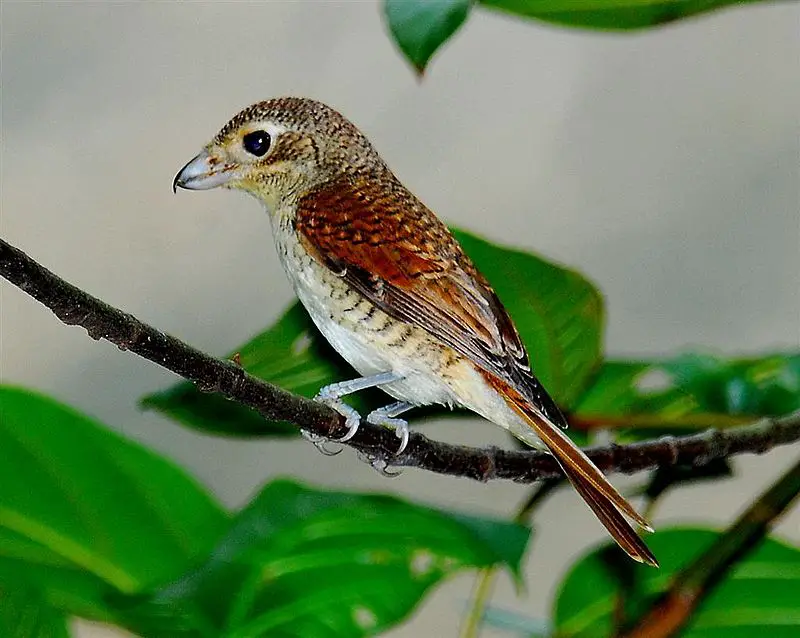
The Tiger Shrike is a small passerine bird found across eastern Asia in wooded habitats. It has pale grey upperparts and white underparts, with black streaks on its wings and tail.
Its head is distinctive – dark crown and nape surrounded by an orange-buff face mask which fades to yellowish-white around the eyes, cheeks and throat.
This shy shrike typically hunts alone, preying upon smaller animals such as insects or lizards.
During mating season it builds its nest high up in trees where it will lay 3-6 eggs at once before incubating them until hatching takes place about 2 weeks later.
The species may be lesser known than other shrikes but this does not diminish their importance to local ecosystems.Scientific classification:
| Kingdom | Animalia |
| Phylum | Chordata |
| Class | Aves |
| Order | Passeriformes |
| Family | Laniidae |
| Genus | Lanius |
| Species | L. tigrinus |
23. White-Faced Heron
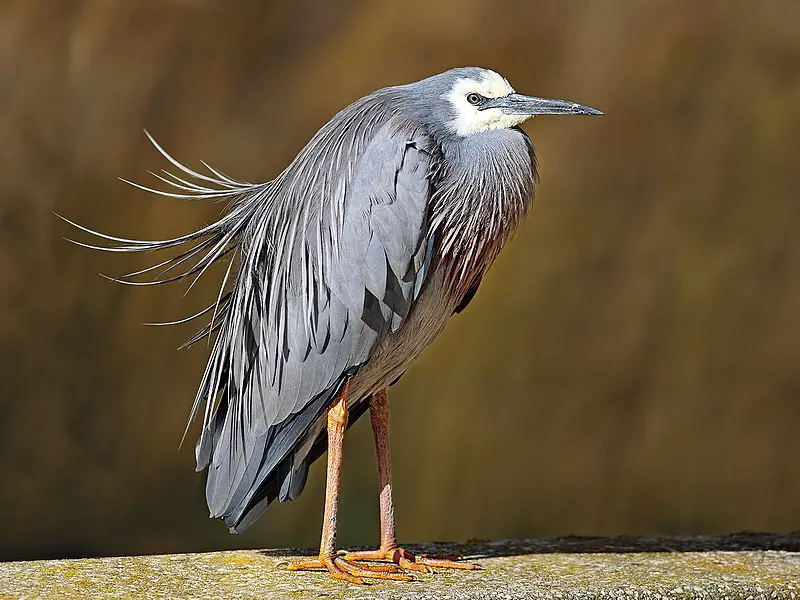
The White-faced Heron is a common sight throughout much of Australasia. With its pale, bluish grey feathers and yellow legs this bird stands out in the crowd.
It can be found on New Guinea, Torres Strait Islands and Indonesia as well as Australia and New Zealand but tends to avoid dry areas. This medium sized heron has one distinct feature – a white face.
Its diet consists mainly of small fish, lizards, frogs insects and crustaceans which it hunts for by wading into shallow water or searching through grasses near wetlands.
In flight they appear graceful with their long neck tucked back against their body giving them an elegant silhouette against the sky.
Their behaviour shows intelligence when finding food sources or evading predators making them interesting creatures to observe in nature.Scientific classification:
| Kingdom | Animalia |
| Phylum | Chordata |
| Class | Aves |
| Order | Pelecaniformes |
| Family | Ardeidae |
| Genus | Egretta |
| Species | E. novaehollandiae |
Also Featured In: Birds of Tasmania, Sydney Birds You Need to See
24. White-Breasted Waterhen
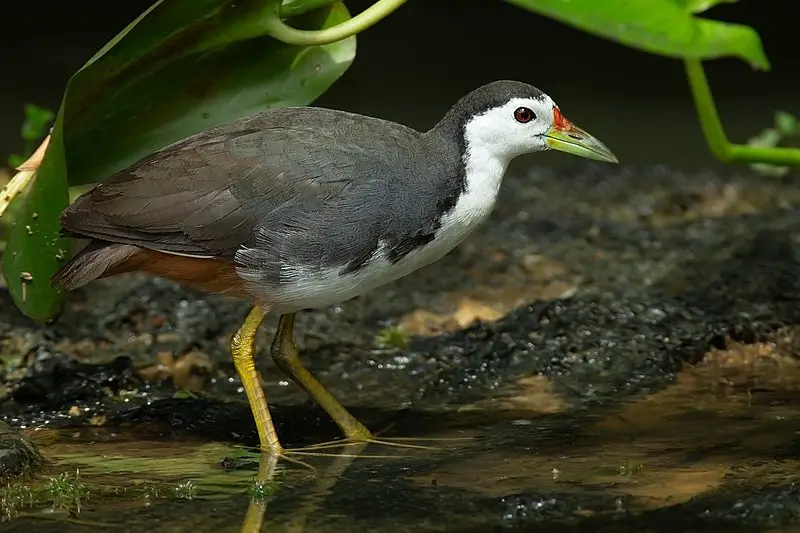
The White-breasted Waterhen is a stunning species of bird from South and Southeast Asia. It has a striking appearance, with its dark slaty plumage contrasted by the clean white of its face, breast and belly.
This bold waterbird can often be seen slowly walking around marshes or even drains near busy roads with its tail held upright in an unmistakable pose.
They are omnivores which feed on both plants and small animals such as insects and invertebrates.
The White-breasted Waterhen plays an important role in their ecosystems as they help to keep it balanced by consuming pests that could potentially cause damage to crops or other plant life if left unchecked.Scientific classification:
| Kingdom | Animalia |
| Phylum | Chordata |
| Class | Aves |
| Order | Gruiformes |
| Family | Rallidae |
| Genus | Amaurornis |
| Species | A. phoenicurus |
25. Christmas Emerald Dove
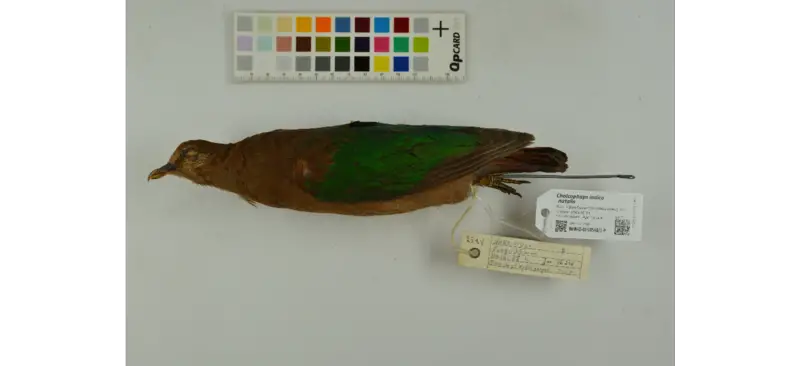
The Christmas emerald dove is a small and distinctive subspecies of the common emerald dove, endemic to Christmas Island. It measures 23-26 cm long with a brownish body complemented by beautiful green wings.
Its diet consists mostly of fruits, seeds and buds found in rainforest habitats on its native island. The bird can also be seen foraging in disturbed areas near human settlements around Christmas Island’s west coast.
During breeding season males make loud cackling calls while displaying their vibrant feathers they use to attract mates during courtship displays.
These birds are now threatened due to habitat loss from deforestation but conservation efforts have been made through replanting trees as well as protecting undisturbed forested areas throughout the island chain which helps maintain healthy populations of this lovely species.Scientific classification:
| Kingdom | Animalia |
| Phylum | Chordata |
| Class | Aves |
| Order | Columbiformes |
| Family | Columbidae |
| Genus | Chalcophaps |
| Species | C. indica |
| Subspecies | C. i. natalis |
26. White Tern
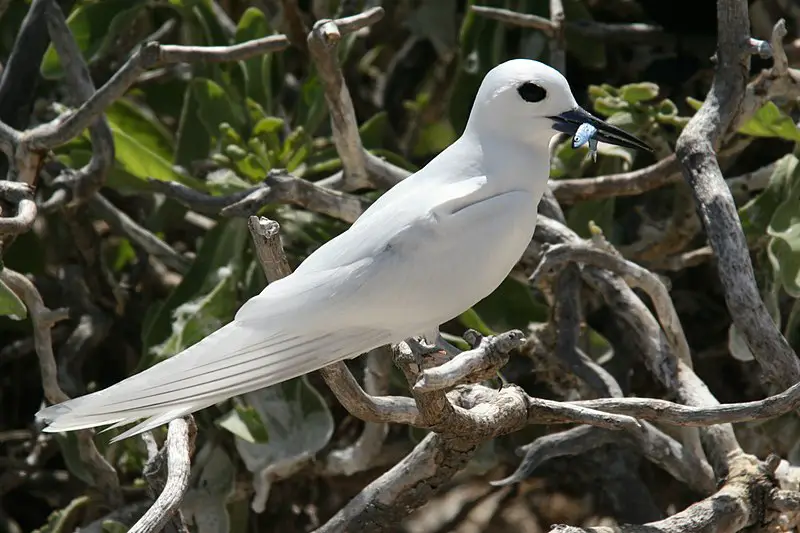
The White tern, also known as the common white tern or Fairy Tern, is a small seabird species found across tropical oceans all over the world.
Known for its elegance and beauty by humans and other animals alike, these birds are truly mesmerizing with their snow-white feathers.
They can be seen soaring in high altitudes or circling around ships at sea looking for food. The Hawaiian name ‘manu-o-Kū’ translates to ‘bird of heaven’ which reflects how majestic this bird looks when it flies through the sky.
These lovely creatures often breed on isolated islands away from predators along with another smaller species called Little White Terns (Gygis microrhyncha).Scientific classification:
| Kingdom | Animalia |
| Phylum | Chordata |
| Class | Aves |
| Order | Charadriiformes |
| Family | Laridae |
| Genus | Gygis |
| Species | G. alba |
27. Green Junglefowl
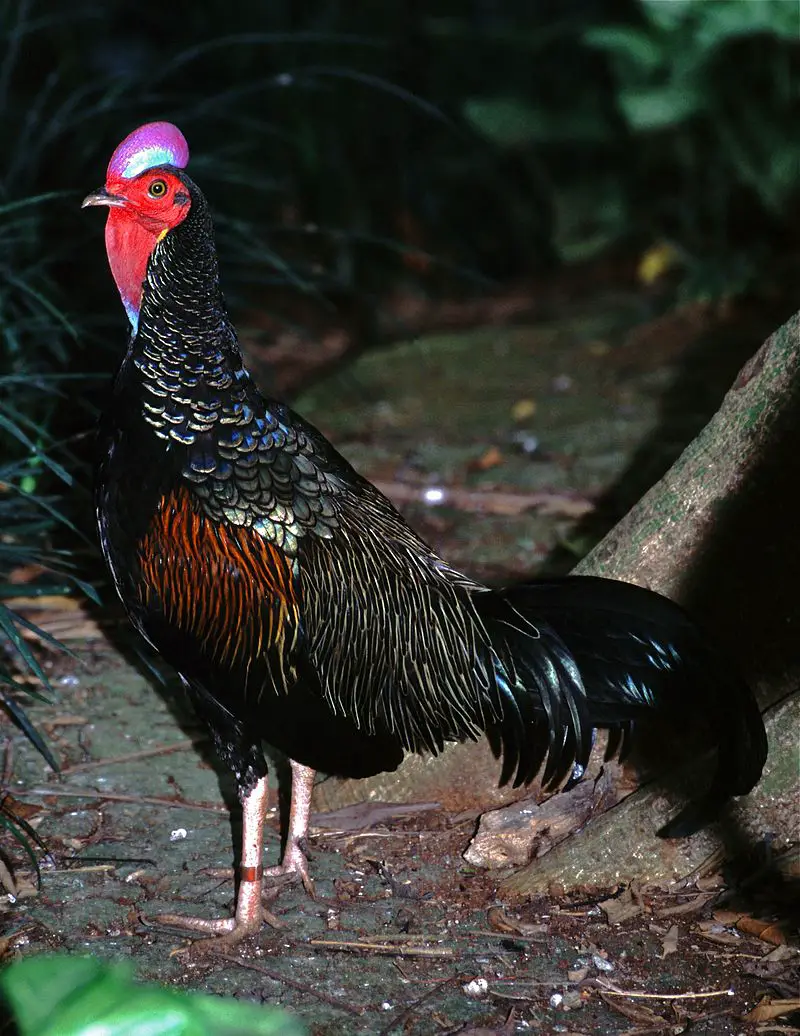
The Green Junglefowl is a species of bird belonging to the pheasant family Phasianidae. It stands up to 75 cm in length and can be found inhabiting dense forests throughout India, Southeast Asia, Indonesia and parts of China.
This beautiful creature has been around for at least four million years making it one of the oldest surviving members of its kind
Its distinct green plumage makes it stand out from other jungle fowls while also making it more vulnerable to predators in its natural environment.
Unfortunately hybridization with domestic chickens has also occurred as reported by some researchers over recent times which could threaten this unique species’ survival if not addressed properly.Scientific classification:
| Kingdom | Animalia |
| Phylum | Chordata |
| Class | Aves |
| Order | Galliformes |
| Family | Phasianidae |
| Genus | Gallus |
| Species | G. varius |
Also Featured In: Java Birds You Should Know, Common Birds of Lombok